The 2nd harmonic is at -26.4dB down from the fundamental, and the 3rd harmonic is at -39.7dB.
Measured 4.7% THD on the AA501A, but all but 1% of that was the 2nd harmonic. No BW limiting filters were used.
Measered 1.3% THD on AA501A w. no filters engaged.
This is the part that puts the tradeoffs in perspective. The good, the bad and the ugly.
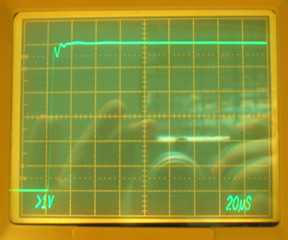
Triode Mode, 1 Watt, max feedback
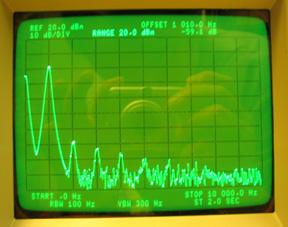
Spectrum of above.
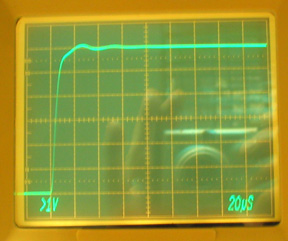
As above but no feedback.
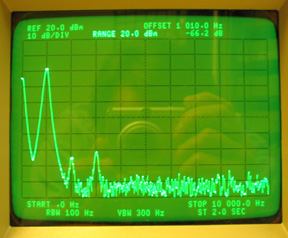
Spectrum of above.
I didn't get my wish that the second harmonic distortion product would be higher than the third (something's too balanced - see later mods), but I did get my wish for a quick rolloff of harmonics in general, by having no feedback. The squarewave response is better with no feedback too. Either one is pretty good relative to what I've seen.
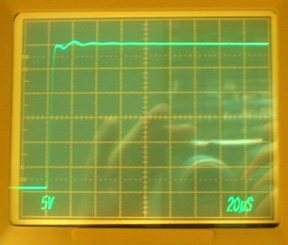
Triode Mode, 12 watts, max feedback.
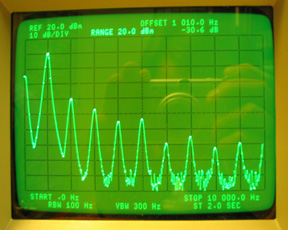
Spectrum of above. This is the ugliest picture. It shows how much of the higher order distortion gets generated by a feedback loop, in spite of the good phase margin and loop bandwidth as is exhibited by the very nice squarewave response.

12 watts still, but no feedback. Some loss of bandwidth but not a problem.
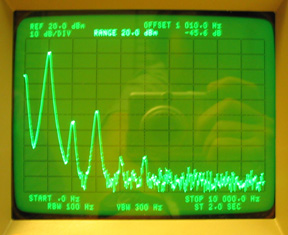
Spectrum of above. Distortion is significant, but there's very little higher order product.

Ultra-Linear mode, 1 watt, max feedback.
This is with no cap at all across the feedback resistance. The squarewave may improve with a cap there.
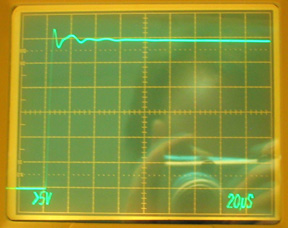
25 watts and max feedback.
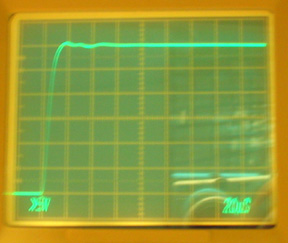
As above, 25 watt, but no feedback.
You can see why no-feedback amps are the high-end. You just have to use speakers that are happy with the amplifiers output (source) impedance (which becomes substantial when there's no feedback to reduce the output impedance).
Power supplies:
At 120VAC line, current draw is 1.64 amps, and 170 watts.
The 6F8G input tube has DC filiment voltage, the rest have AC. All filiments are at 6.2 volts DC or rms.
B+ = 403 VDC no signal. 393VDC with one channel at clipping.
The lower B+ means less power out, but it also means we can run the EL34's with more quiescent current (closer to class A) without exceeding the power dissipation rating of the tube. Tenatively I've got the EL34's set at 45mA each. I'll take another look when I get a chance, and see how far from the power dissipation limit I am.
Gain of 6F8G stage:
Channel 1 = 30vpk / 3.25v pk = 9.23 or 19.3dB
Channel 2 = 32v pk / 3.25v pk = 9.85 or 19.8 dB
6F8G Bandwidth:
With Rf filter on input = 62kHZ.
Without Rf filter on input = 750kHZ.
Gain of 6SN7 diff-amp stage (no feedback):
Channel 1 = 15v pk / 1.8v pk = 8.33 or 18.42 dB
Channel 2 = 15.5v pk / 1.8v pk = 8.6 or 18.7dB
Triode mode Voltage Gain of
6SN7 (no feedback) > EL34 stage > output transformer > 10 ohm load resistor (6F8G stage excluded):
=3.95 or 11.9dB.
Triode mode Voltage Gain of
EL34 > transformer > 10 ohm load
= 0.45 or -6.85dB, relative to the voltage swing at only one EL34 grid.
Triode mode gain of whole amp (see note at bottom of page):
no feedback =15v pk / 0.35v pk = 42.8 or 33dB.
max feedback = 15v pk / 1.75v pk = 8.6 or 18.7dB.
22 dB was the goal, but not at all critical.
Gain differential due to feedback = 14.3dB
Power Out into 8 ohms:
16 W rms in Triode mode
31 W rms in Ultra Linear mode.
The 70 HZ one pole highpass filter cap at the input effectively doubles the power (at least) available from this amp (below that is handled by a sparate woofer system with it's own poweramp).
Bandwidth of whole amp:
Low end (without the 70HZ highpass filter):
-3dB at 10 HZ. Waveshape pretty distorted.
At 20 HZ waveshape distortion is more reasonable.
High end (no feedback):
-2.5dB at 40kHZ, -3dB at 67kHZ, and -6dB at 103kHZ.
(God was on my side).
Ultralinear mode had a bit more ringing on the square wave, about 1.5 minors with a 6 major division signal. Triode mode ringing was better damped to within a minor div with a 6 major div signal.
Output impedance of amp:
Triode mode, no feedback = 3.4 ohms.
Triode mode, max feedback = 0.8 ohms.
Ultra Linear mode, no feedback = 8.8 ohms
Ultra Linear mode, max feedback = 1.4 ohms
As you can see here, the calibration of the passive crossover at the speaker will be messed with significantly by these output impedances. Virtually all crosover designs assume a zero ohm source impedance. In a one pole crossover, the poles would be moved down in frequency, but not by the same amount. This is due to the changed circuit impedance differentials, as viewed by the reactive crossover components (cap and coil) at the crossover frequency between the tweeter and the midrange drivers. The tweeter in my case is 7 ohms and the mids are 13.5 ohms at 3.5kHZ. With a higher order crossover (2 pole and above), the curve shapes would be thrown off even more, which could get pretty ugly.
You've got to pick a mode and feedback amount (triode mode with 7dB of feedback, , for example (2.1 ohms)), before trying to calibrate the crossover. Other modes and feedback amounts then get labelled "experimental" since they will somewhat un-calibrate the passive crossover at the speaker system. This is one of the reasons why it's hard to do a fully valid listening comparison.
Gain differential of Triode mode vs. Ultralinear mode:
U.L = 34.9 dB (no feedback), Triode = 30 dB.
Differential = 4.9dB
Note: Since minor mods that affected gain were done during testing (a 33K ohm was added from 6F8G grid to ground to reduce impedance and thereby hum), the numbers closest to the bottom of this list are to be considered more final, if there's any discrepency.

![]()